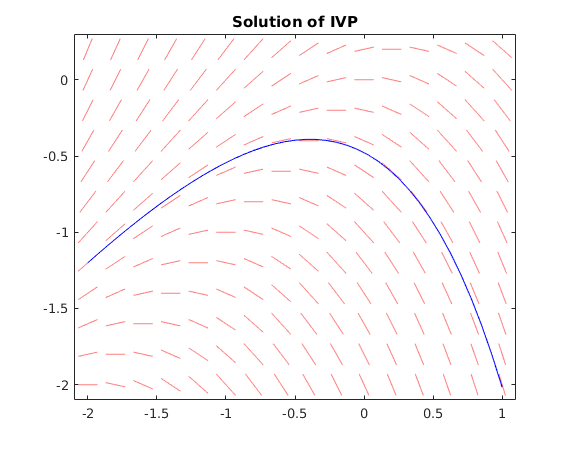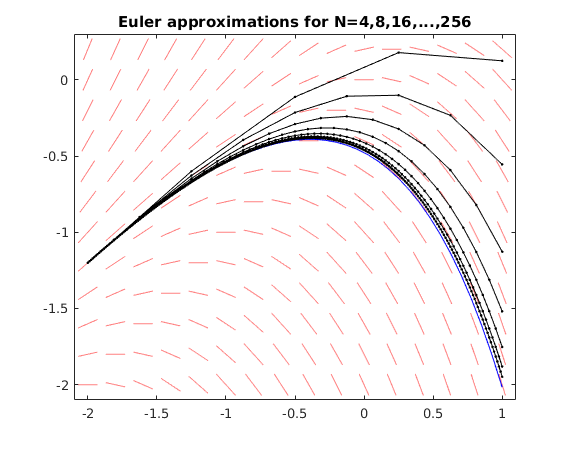Example for Euler method
Contents
You need to download an m-file
You have to download the m-file dirfield.m.
function euler_demo
format short g
Initial value problem
We consider the initial value problem

and we want to find the solution y(t) for t in [-2,1].
We use ode45 to find the solution of the initial value problem and obtain the approximation -2.01711 for y(T).
We plot the solution together with the direction field.
f = @(t,y) y-t; % define function f(t,y) dirfield(f,-2:.2:1, -2:.2:0.2); hold on t0 = -2; y0 = -1.2; % initial point T = 1; % final t-value [ts,ys] = ode45(f,[t0,T],y0); % solve IVP yfinal = ys(end); % value for y at time T fprintf('y(T) = %g\n',yfinal) plot(ts,ys,'b') % plot solution title('Solution of IVP')
y(T) = -2.01711

Use Euler method with N=4,8,16,...,256
We see that the Euler approximations get closer to the correct value y(T)=-2.01711 as N increases.
When we double the value of N the error gets divided by about 2. This means that the error is bounded by  : The Euler method converges with order
: The Euler method converges with order  .
.
olderr = NaN; for N = 2.^(2:8) [ts,ys] = Euler(f,[t0,T],y0,N); err = ys(end)-yfinal; % error fprintf('N = %3g, approx.for y(T) = %10g, error = %10g, quotient = %g\n',N,ys(end),err,olderr/err) olderr = err; plot(ts,ys,'k.-') % plot Euler solution end hold off title('Euler approximations for N=4,8,16,...,256')
N = 4, approx.for y(T) = 0.124219, error = 2.14133, quotient = NaN N = 8, approx.for y(T) = -0.555357, error = 1.46176, quotient = 1.4649 N = 16, approx.for y(T) = -1.12729, error = 0.889824, quotient = 1.64275 N = 32, approx.for y(T) = -1.51891, error = 0.498202, quotient = 1.78607 N = 64, approx.for y(T) = -1.75231, error = 0.264799, quotient = 1.88143 N = 128, approx.for y(T) = -1.88043, error = 0.136683, quotient = 1.93732 N = 256, approx.for y(T) = -1.94765, error = 0.0694635, quotient = 1.9677

code of function Euler(f,[t0,T],y0,N)
At each step we evaluate the slope s=f(t,y) and then update y=y+s*h, t=t+h.
function [ts,ys] = Euler(f,tv,y0,N); t0 = tv(1); T = tv(2); h = (T-t0)/N; % stepsize h ts = zeros(N+1,1); ys = zeros(N+1,1); t = t0; y = y0; % initial point ts(1) = t; ys(1) = y; for i=1:N s = f(t,y); % evaluate direction field at current point y = y + s*h; % follow line with slope s from t to t+h t = t + h; ts(i+1) = t; ys(i+1) = y; % store result in vectors ts,ys end end
end